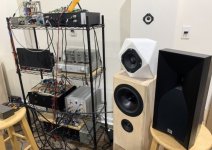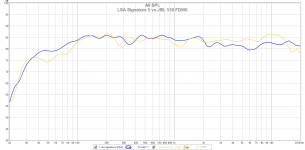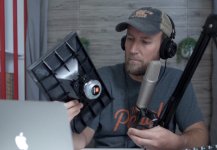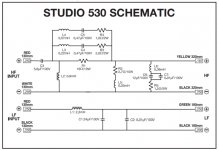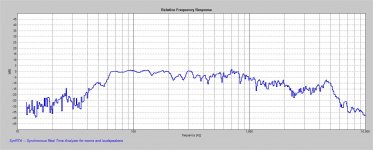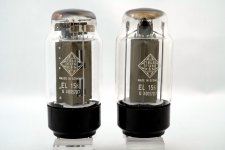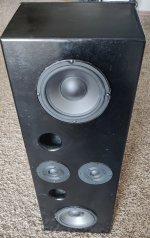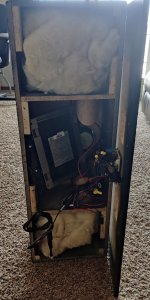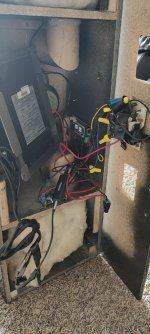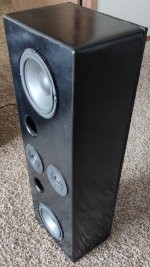FOR SALE: A pair of NOS Bohlender Graebener "Ribbon" Transducers RD 50 and RD 75
I bought a couple of pairs of RD 75s and RD 50s for a home theater, but before proceeding I determined that my room size did not warrant having a full home theater based on the Radia ribbons. Although I'll be keeping a pair of RD 50 and a pair of RD 75 for myself, the rest will be sold. These are my last remaining RD 50's and RD 75's that will be sold (I'm keeping a couple of pairs for myself).
If you are looking at this ad, then you know that the B&G drivers' stereo imaging abilities are truly amazing. Superb soundstage. Super light diaphragms result in extremely low distortion. They play clean and can achieve high listening volumes. They are best described as dynamic, smooth and ultra clean. The Radia Series of drivers shatter the performance barrier that is inherent with conventional high-performance loudspeakers:
› Flexible Exclusive line-source Radia planar technology produces a cylindrical sound field, eliminating any unwanted mid and high-frequency floor and ceiling reflections.
› Dynamic Accurately reproduces dynamic peaks at high power for realistic reproduction.
› Lifelike Planar ribbon drivers provide amazing clarity, resolution and fidelity. Critically acclaimed, the Radia ribbons are used in speakers that are favorite among audiophiles and reviewers from around the world.
The RD50 are Planar–magnetic transducers with true line source characteristics and represent the ultimate thin film diaphragm technology. The RD drivers were the only commercially available products on the market that possessed true line source characteristics. They generate a continuous and perfectly coupled wavefront even at the highest frequencies. Other discrete (multiple-driver) designs exhibit severe lobing, energy leakage, and chaotic spectrum balance changes along the listening axis. In addition to being a nearly perfect line source, the RD drivers have all of the advantages unique to planar ribbon transducers-- unsurpassed transparency and accuracy of reproduction.
The RD driver can be implemented as a dipole mounted on an open baffle, as a monopole with a rear enclosure, or as an in-wall loudspeaker. This offers the designer unlimited freedom of creativity, enabling the construction of very exquisite and unique loudspeakers.
Unique features:
• Extremely wide and even horizontal dispersion throughout the reproduced frequency range. This yields a highly stable "sweet spot", vastly expanded soundstage, and improved stereo imaging;
• Little-to-no vertical dispersion, which eliminates annoying reflections of sound from ceilings and floors, helping to deliver superior clarity and intelligibility. The designer can greatly reduce harmful room affects from the equation;
• Sound pressure level drops off at half the rate (-3dB) of conventional speakers (-6dB) with a doubling of distance;
• The driver is very easy to drive due to the purely resistive load presented to the amplifier;
• Due to the large radiating surface area, very little driver excursion is required to produce a given SPL, resulting in very low levels of distortion;
• The driver is capable of reproducing sound over seven octaves, requiring no crossover in the critical midrange region. The lack of a crossover in this region removes phase incoherency in the critical midrange, helping preserve the spectral and temporal integrity of vocal recordings;
• The RD series drivers can handle large amounts of power with ease due to the excellent dissipation of heat over the entire surface area of the diaphragm.
Driver Construction:
The RD drivers are manufactured as dipoles, with nearly identical output from the front and back of the element. The drivers feature a highly effective push-pull symmetric magnet system (Ceramic 8 magnets are located on both sides of the diaphragm). Having symmetric magnets insures maximum SPL output, minimum distortion, and a cost-effective design. The diaphragm is made of a very thin polyester (PET) film with laminated aluminum strips creating a planar spiral voice coil. The tensioned diaphragm is extremely light, with a mass very close to the mass of the associated air volume that vibrates along with the diaphragm. This close coupling of mass allows the driver to exhibit immediate and precise response to micro-dynamic changes in the recorded signal. The driver frame is comprised of three layers of high-strength steel that provide structural rigidity and maintain critical tolerances. The RD drivers' solid construction makes it free from any inherent structural resonances.
The RD series of loudspeaker drivers offer the systems designer the advantages of a thin-film, line-source transducer with very high performance potential for fixed installation sound reproduction. Unlike most exotic driver types, the RD Series models feature unmatched bandwidth, power handling and ruggedness, as well as the ease of an almost entirely resistive load to the amplifier. All models in the RD Series feature linear, push-pull Ceramic 8 motors linearly driving a polyester diaphragm whose moving mass is actually less than the air load. The bandwidth of the RD Series drivers is extraordinarily large, and is usable from as low as 150Hz to beyond audibility. The diaphragm is protected within a chassis made of three layers of heavy gauge, self-reinforced steel.
Crossover Suggestions:
The RD line-source elements offer many possibilities in system design; however their correct implementation is very important for the best results. Normally, an RD series driver is capable of reproducing sound in the 150 Hz – 20 kHz range. However, for each particular design the specific application must be considered when choosing the low frequency crossover point and filter slope. Large rooms with high absorption, high playback levels, or long listening distances usually require a somewhat higher crossover frequency and filter slope (200-300 Hz high pass crossover with at least 4th order slope). In an average or small sized room with low absorption and shorter listening distance, a 150-200 Hz crossover point with a 3rd order slope may be used.
Recommended Notch Filter Use and Application
For optimum performance of the BG RD series drivers, it is recommended that a simple notch filter be installed. This notch filter corrects for cavity resonances between the magnet structure and the diaphragm in the 5K to 6K range. The notch filter is placed in the positive signal path prior to the RD element and can be used in addition to other crossover elements. To achieve a flat frequency response throughout the entire spectrum, it is highly recommended a notch filter be used.
Dipole Suggestions:
In dipole or open baffle situations, low frequency extension and SPL output is largely dependent on baffle size and geometry. To achieve a sufficient low-end response, a minimum baffle width of 12" is recommended. Generally speaking, a baffle with irregular or sloped side(s) (e.g. trapezoidal) will yield a smoother response due to the spreading out of baffle edge diffraction effects. In dipole situations, special attention should be given to in-room speaker placement and room acoustic treatment. A minimum distance to the rear wall of 2 feet is recommended with the use of absorptive/diffusive materials on the rear wall between left and right speakers.
Sealed Enclosure Suggestions
If the driver is used in a sealed enclosure, the depth of the cabinet and amount of dampening will significantly affect the driver performance. For optimum results, the largest possible enclosure depth should be used; a minimum for best performance is roughly 3-1/2". The rear enclosure should be filled with Acousta Stuff, fiberglass, or similar acoustic damping material. Additional damping material such as Black Hole 5 or medium density 1/4"– 1/2“ felt on the rear of the enclosure is highly recommended. As in all loudspeaker cabinets, non-parallel walls, good-quality construction, and effective bracing will improve performance by reducing cabinet resonances and standing waves.
Subwoofer Integration
A matching subwoofer/woofer system should have a high level of resolution for the best sonic integration with the RD series drivers. It is recommended to use at least a 2nd order low-pass crossover on the woofer. Better results can be achieved with higher order crossovers. The use of high order active electronic crossovers is also recommended.
Radia ribbons are hard to find and will get harder and harder to find as the months and years go by. Any new owner will be very proud to acquire such amazing driver units. Do a web search and you will find many applications for the driver and easy DIY projects. These drivers were used in speakers costing tens of thousands of dollars.
Crossover network recommendations:
150Hz, minimum, 12 dB/oct. electrical minimum
RD 75 Specifications:
Power handling: 100 watts RMS/400 watts max • Nominal impedance: 6 ohms • Re: 6.0 ohms • Frequency range: 150-18,500 Hz • SPL: 88 dB 1W/1m • Net weight: 35.5 lbs. • Dimensions: 75.563” L x 4.675” W x 1.53” D
RD 50 Specifications:
Power handling: 70 watts RMS/270 watts max • Nominal impedance: 4 ohms • Re: 4.0 ohms • Frequency range: 150-18,500 Hz • SPL: 88 dB 1W/1m • Net weight: 25.2 lbs. • Dimensions: 51-1/2" L x 4-11/16" W x 1-1/2" D.
